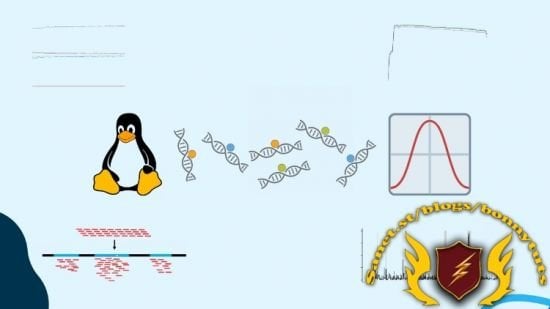
Published 6/2024
Created by Abdul Rehman Ikram
MP4 | Video: h264, 1280×720 | Audio: AAC, 44.1 KHz, 2 Ch
Genre: eLearning | Language: English | Duration: 24 Lectures ( 2h 55m ) | Size: 1.2 GB
Master ChIP-seq Data Analysis: From Quality Control to Peak Annotation and Motif Finding Using Bioinformatics Tools
What you’ll learn:
Understand the Principles of ChIP-seq: Gain a comprehensive understanding of the principles and applications of ChIP-seq technology in biological research.
Familiarity with ChIP-seq Workflow: Become proficient in the overall ChIP-seq workflow, from experimental setup to data analysis.
Install and Configure Bioinformatics Tools: Learn how to install and configure essential bioinformatics tools required for ChIP-seq data analysis, including Fas
Perform Quality Control: Conduct quality checks on raw sequencing data and remove adapters using Fastp.
Align Sequencing Reads to Reference Genome: Align sequencing reads to a reference genome using BWA and handle the resulting SAM files.
Process and Manage BAM Files: Convert SAM files to BAM format, sort, and index BAM files using Samtools, ensuring efficient data management and analysis.
Filter Reads by Mapping Quality: Filter sequencing reads based on mapping quality to retain high-quality data for downstream analysis.
Perform Peak Calling: Identify protein-DNA binding sites by performing peak calling using MACS2, and understand the significance of peaks in ChIP-seq data.
Annotate Peaks: Annotate identified peaks with genomic features using HOMER, gaining insights into the biological relevance of binding sites.
Discover Motifs: Conduct motif analysis using HOMER to identify DNA sequence motifs enriched at binding sites, enhancing the understanding of regulatory element
Learn practical and in-demand skills for ChIP-seq data analysis.
Gain hands-on experience with essential bioinformatics tools.
Prepare for advanced studies or career opportunities in bioinformatics and computational biology.
Requirements:
No prior bioinformatics experience is necessary; the course is beginner-friendly.
Basic Understanding of Biology: Familiarity with basic biological concepts, particularly in genetics and molecular biology, is helpful but not required.
Introductory Knowledge of Bioinformatics: Basic knowledge of bioinformatics concepts is advantageous, but beginners are welcome.
Computer Literacy: Basic computer skills, including file management and software installation.
Access to a Computer: A computer (Windows, Mac, or Linux) with internet access for downloading software and datasets.
Willingness to Learn: An eagerness to learn new tools and techniques in bioinformatics.
Text Editor: Installation of a text editor (e.g., Notepad++, Sublime Text, or VS Code) for viewing and editing scripts.
Linux Environment: While not required, having access to a Linux environment or the ability to install and use the Windows Subsystem for Linux (WSL) can enhance the learning experience.
Description:
Unlock the power of ChIP-seq data analysis with our comprehensive course, Learn ChIP-seq Data Analysis Using Bioinfo Linux Pipeline. Whether you’re a beginner or looking to expand your bioinformatics skills, this course provides a step-by-step guide to mastering ChIP-seq analysis using essential bioinformatics tools.What You’ll Learn:Understand the principles and applications of ChIP-seq technology.Perform quality control and adapter removal on raw sequencing data.Align sequencing reads to a reference genome and manage SAM/BAM files.Filter high-quality reads and conduct peak calling to identify protein-DNA binding sites.Annotate peaks with genomic features and discover DNA sequence motifs.Course Modules:Introduction to ChIP-seq: Learn the basics of ChIP-seq technology and its workflow.Theoretical Foundations and Tools: Explore the key tools and files used in ChIP-seq analysis.Linux Essentials for Bioinformatics: Get started with Linux commands and learn to use Linux in Windows.Practical Pipeline Implementation: Gain hands-on experience with each step of the ChIP-seq data analysis pipeline, from quality control to motif finding.Intended Learners:Bioinformatics enthusiastsStudents and researchers in biology, genetics, or bioinformaticsLaboratory technicians and scientistsData scientists and computational biologistsBioinformatics instructors and educatorsBiotechnology and pharmaceutical industry professionalsSelf-learners and career changersPrerequisites:No prior bioinformatics experience is required.Basic understanding of biology is helpful but not mandatory.Basic computer skills are required.Join us to gain practical, in-demand skills in ChIP-seq data analysis. By the end of this course, you’ll be proficient in using a bioinformatics Linux pipeline to analyze ChIP-seq data, preparing you for advanced studies or career opportunities in bioinformatics and computational biology.
Password/解压密码www.tbtos.com
转载请注明:0daytown » Learn ChIP-seq Data Analysis Using bioinfo Linux Pipeline